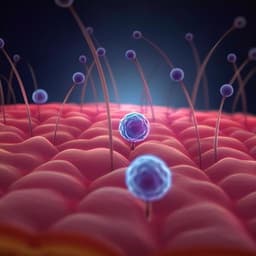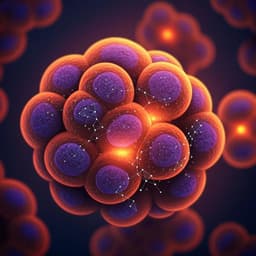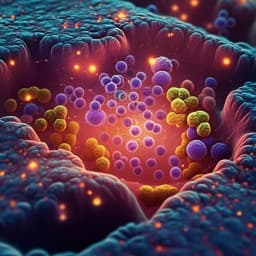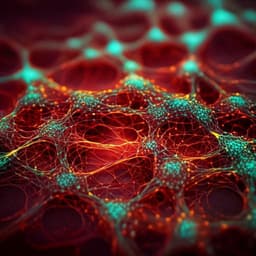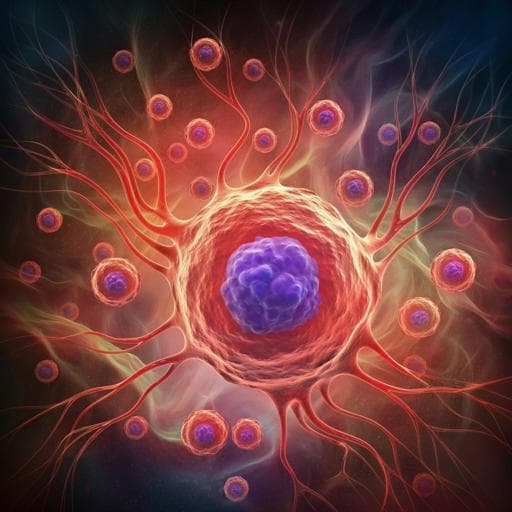
Medicine and Health
Engineering a niche supporting hematopoietic stem cell development using integrated single-cell transcriptomics
B. Hadland, B. Varnum-finney, et al.
Discover groundbreaking insights into hematopoietic stem cell formation from hemogenic endothelium through innovative single-cell RNA sequencing. This research, conducted by Brandon Hadland, Barbara Varnum-Finney, and colleagues, unveils critical gene expression dynamics that facilitate HSC development and engrafting capabilities.
~3 min • Beginner • English
Introduction
The study addresses the long-standing challenge of defining the cell-intrinsic programs and niche-derived signals that orchestrate the emergence of long-term engrafting hematopoietic stem cells (HSCs) from hemogenic endothelium (HE) in the embryonic aorta-gonad-mesonephros (AGM) region. HSCs arise within an arterial environment, implicating arterial endothelial programs and vascular niche cues (e.g., Notch) in HSC specification. However, rarity and asynchrony of HSCs relative to co-emerging progenitors hinder molecular dissection. The authors aim to map, at single-cell resolution, the transcriptional dynamics of HE-to-HSC transition and the complementary signaling repertoire of niche endothelial cells, to identify ligand-receptor interactions sufficient to specify, mature, and self-renew HSCs and to translate these into a stromal cell–independent engineered niche capable of generating engrafting HSCs ex vivo.
Literature Review
Embryonic hematopoiesis proceeds through waves preceding definitive HSC emergence, with HE in arterial vessels as the source of HSCs. Prior work implicates arterialization and Notch signaling in definitive hematopoiesis and HSC formation. Phenotypic characterization identified transitional VE-Cadherin+CD41+/−CD45+/− pre-HSC stages, but rare HSCs are outnumbered by progenitors in intra-aortic clusters. Recent single-cell transcriptomic studies profiled HE, pre-HSCs, and early HSCs, supporting arterial HE origin and defining gene signatures (arterial EC markers; HSC-primed HE; pre-HSC/HSC gene sets). Niche influences from endothelial cells can support Notch-dependent HSC self-renewal. However, an integrated map linking niche ligands to receptors on developing HSCs, and functional validation of these interactions to engineer HSC generation, remained incomplete.
Methodology
Study design integrated complementary single-cell RNA-sequencing (scRNA-seq) of: (1) independently derived Akt-activated AGM endothelial cell (AGM-EC) lines differing in their ability to support HSC generation from embryonic precursors; (2) primary AGM VE-Cadherin+CD61+EPCR+ (V+61+E+) cells across E10–E11 enriched for HSC precursors; (3) progeny of single V+61+E+ cells after 4 days of AGM-EC co-culture (capturing self-renewing HSCs and early HSC-to-HPC differentiation); and (4) progeny of bulk V+61+E+ cells after 6 days in AGM-EC versus engineered niche conditions. Cells were sorted by FACS with index sorting for single-cell assays. scRNA-seq libraries were prepared with 10x Genomics Chromium Single Cell 3' v2 and sequenced (Illumina NextSeq 500). Computational analysis used Cell Ranger for alignment (mm10), Monocle (v2.99.3) for normalization, UMAP for dimensionality reduction, Louvain clustering, marker-based cell type classification, and Monocle pseudotime trajectories. Differential gene expression over pseudotime identified dynamic modules. Gene-set scoring used published signatures: arterial EC, HSC-primed HE, AGM pre-HSC, E11 AGM HSC, adult BM HSC. A curated ligand-receptor database (Ramilowski et al.) was intersected with expressed ligands in niche EC (HSC-supportive AGM-EC and primary arterial EC) and receptors in developing HSCs (HSC precursors in vivo and HSCs generated in vitro), stratified by pseudotime enrichment. Circos plots visualized pathway-level interactions (integrins/adhesion, cytokines/chemokines, growth factors, Notch, Wnt, TGF-β/BMP, guidance cues). Functional validation: An engineered, stroma-independent niche was assembled with immobilized Notch-activating reagents (Dll1-Fc or anti-Notch1 and anti-Notch2 monoclonal antibodies), VLA-4/5 ligands (fibronectin fragment FN-CH-296 or VCAM1-Fc), serum-free media with cytokines (SCF 100 ng/ml, IL-3 20 ng/ml, TPO 20 ng/ml), and TGF-β receptor inhibitor (LY364947, 10 µM), with or without recombinant CXCL12 (100 ng/ml). Sorted E9–E11 V+61+E+ cells were cultured 6–7 days. Flow cytometry assessed HSC phenotype (VE-cadlow/− CD45+ Gr1− F4/80− Sca1high EPCRhigh). Transplantation into lethally irradiated adult recipients measured long-term multilineage engraftment (≥16–24 weeks; secondary transplants in some experiments). Additional methods included immunohistochemistry for in situ protein expression in E10.5 embryos and validation of integrin receptor expression (e.g., VLA-4/CD49d) on HSC precursors by flow cytometry. All animal procedures followed approved protocols.
Key Findings
1) HSC-supportive vs non-supportive AGM-EC: scRNA-seq and UMAP clustering separated non-supportive EC from three supportive EC lines. HSC-supportive EC showed enrichment for genes in adhesion/integrin interactions, signaling receptor binding, and anti-apoptosis. Differentially expressed ligands and arterial transcriptional features included Sox17, Cxcl12, Fn1, Vcam1, Icam1, Tgm2, Col5a2. 2) Enrichment of HSC precursors: VE-Cadherin+CD61+EPCR+ (V+61+E+) phenotype across E9–E11 significantly enriched functional HSC precursors (HSC CFC) spanning HE (CD41−CD45−), pro-HSC/pre-HSC I (CD41+CD45−), and pre-HSC II/HSC (CD45+), validated by index sorting with AGM-EC co-culture and serial transplantation. 3) Developmental trajectory in vivo: scRNA-seq of 3092 V+61+E+ cells (E10–E11) revealed pseudotemporal progression from arterial EC/HE (Dll4, Gja5, Nrp1, Sox17, Foxc2, Gata2) to pre-HSC/HSC (Pdzklip1, Hlf, Etv6, Mycn; self-renewal regulators Erg, Kdm6b, Mllt3, Mecom, Pbx1, Sirt6), then to progenitors (Flt3, Il7r, Csf3r, Fcgr3). In silico criteria defined an “HSC precursor” cell type co-expressing nine validated HSC/HE markers (Gfi1, Mycn, Pdzklip1, Procr, Dll4, Vwf, Cdkn1c, Pbx1, Mllt3) while lacking progenitor markers, numerically matching HSC CFC estimates and including HE lacking CD41/CD43/CD45. Gene-set scores confirmed overlapping arterial and HSC signatures in HSC precursors. Notch dynamics showed decreasing Notch1, increasing Notch2, downregulation of arterial Notch targets (Hey1/Hey2) and increased Cdca7 during HE-to-HSC transition; Hes1 and Gata2 decreased with progenitor differentiation. 4) Self-renewing HSCs in vitro: scRNA-seq of progeny from single V+61+E+ cells after AGM-EC co-culture identified a homogeneous HSC-like colony expressing Pdzklip1, Procr, Fgd5, Vwf, Cdkn1c (with some Mki67), lacking Itgal and Cd48; and a mixed colony with both HSC-Type and HPC-Type cells. Pseudotime from HSC to HPC showed upregulation of early lineage genes (e.g., Cebpa, Ebf1). Notch targets (Hes1, Gata2) were enriched early in HSC state and downregulated upon HPC differentiation. 5) Ligand-receptor interactome: Integration of niche EC ligands with HSC precursor and HSC receptors identified signaling axes across Notch, Wnt, BMP/TGF-β, Hedgehog, Ephrins, chemokines (CXCL12/CXCR4), IGFs, endothelin, adrenomedullin, P-selectin, Pleiotrophin, Angptl, CD44, and extensive integrin/adhesion interactions (e.g., Fn1–integrins; Vcam1–VLA-4). Novel candidate interactions and modulators were highlighted. 6) Engineered niche and functional validation: A stroma-free platform combining immobilized Notch1/Notch2 agonist antibodies (or Dll1-Fc), VLA-4/5 ligand (FN-CH-296 or VCAM1-Fc), SCF/IL-3/TPO, and TGF-β receptor inhibition supported generation of long-term engrafting HSCs from E11 V+61+E+ cells (e.g., E11: IgG 0/4 vs Dll1-Fc 2/9 vs anti-Notch1/Notch2 4/8 engrafted recipients). For earlier E10 precursors, addition of CXCL12 was required together with Notch activation and an integrin ligand (e.g., combinations yielding engraftment 7/15 and 4/9 recipients), consistent with CXCR4 expression on rare E9–early E10 HSC precursors and its downregulation by late E10. 7) Comparison of outputs after extended culture: scRNA-seq after 6 days in engineered conditions produced rare HSC/MPP and broad lineage outputs; compared to AGM-EC, engineered cultures showed relative skewing toward early T lymphoid fate and reduced B, monocyte/macrophage, and late erythroid outputs, implying stronger Notch or missing additional niche cues.
Discussion
The integrated single-cell analyses delineate the overlapping arterial endothelial and HSC-specific programs that uniquely characterize HSC emergence from HE and identify dynamic Notch signaling changes underpinning this transition. Complementary profiling of HSC-supportive niche endothelium exposed a ligand repertoire—particularly integrin ligands and CXCL12—aligned with receptors on HE/HSC precursors. Functionally, a minimal engineered niche combining receptor-specific Notch activation, VLA-4/5-mediated adhesion, cytokines, TGF-β pathway modulation, and stage-specific CXCL12 was sufficient to generate engrafting HSCs from embryonic precursors, including pre-E11 stages when paired with CXCL12. These findings address the central question of which niche-derived interactions are necessary and sufficient for HSC specification and self-renewal and provide a roadmap to rationally build ex vivo HSC-generating systems. The work underscores the importance of integrin-mediated adhesion and chemokine signaling in early specification, coordinated with precise Notch receptor activation, and suggests further optimization via temporal modulation of Notch, Wnt, and TGF-β signals and incorporation of additional niche factors (including non-endothelial sources) to balance HSC maintenance and differentiation.
Conclusion
This study defines a comprehensive transcriptional and interaction map for HSC development from arterial-like HE by integrating scRNA-seq of rare HSC precursors, self-renewing HSCs generated in vitro, and niche endothelial cells. It identifies key ligand-receptor axes—Notch1/2, integrins (VLA-4/5), and CXCL12/CXCR4—as necessary components and demonstrates that their integration in a stroma-independent engineered niche yields functional, long-term engrafting HSCs from embryonic precursors. The work advances the translational goal of de novo HSC generation and provides a framework to refine culture conditions, including stage-specific and temporal tuning of signaling pathways and addition of further niche cues, to enhance HSC specification, self-renewal, and lineage balance.
Limitations
The VE-Cadherin+CD61+EPCR+ population, while enriched for HSC precursors, remains functionally heterogeneous at single-cell resolution; in silico identification was required to pinpoint putative HSC precursors in scRNA-seq data. Immunostaining detected cells co-expressing VE-Cadherin, CD61, and EPCR in intra-aortic clusters, but current markers/reporters cannot localize pre-HSC/HSC at single-cell resolution in vivo. Spatial context of niche interactions in the AGM is therefore unresolved; future spatially resolved single-cell multi-omics will be necessary to map the exact locations and cellular interactions governing HSC emergence.
Related Publications
Explore these studies to deepen your understanding of the subject.



